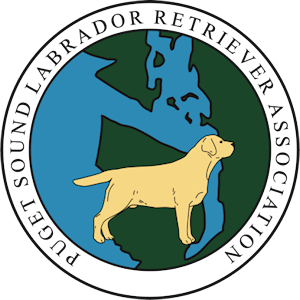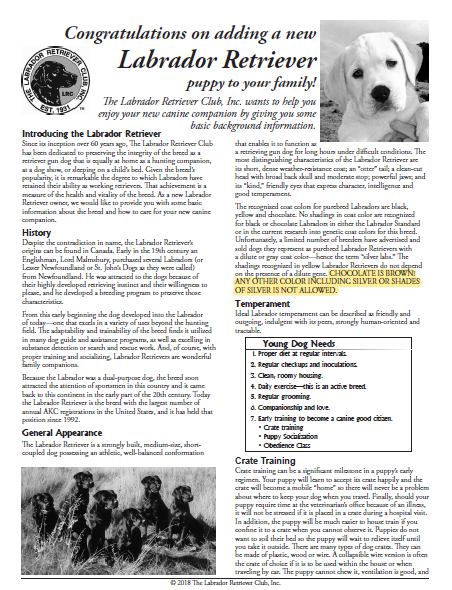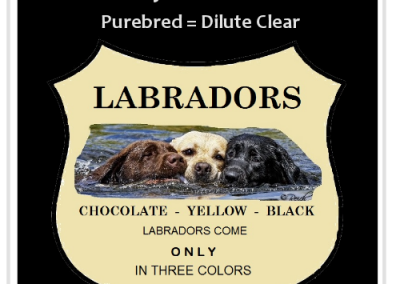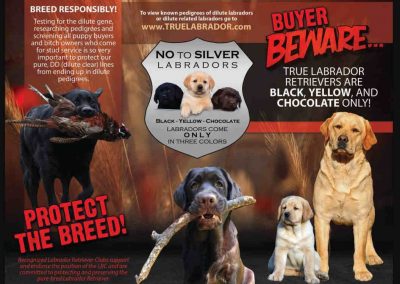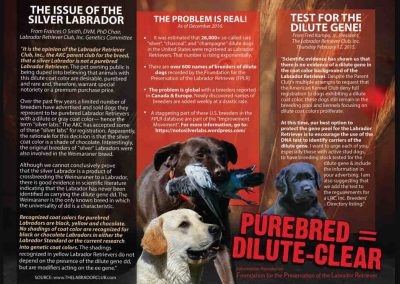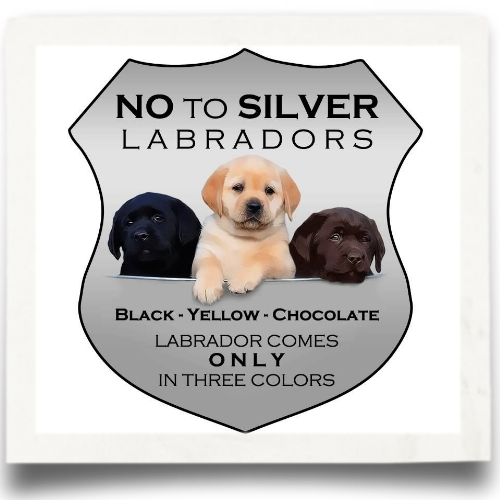
What is a Labrador?
The Labrador Retriever is currently the most popular dog in the United States. One reason for that popularity is the amazing versatility of the breed. Labradors excel as guide dogs, in the show, obedience, rally, and agility rings, as therapy animals, as hunting companions, in search and rescue work, and, of course, as family pets. [Read More]
LRC Breed Standard
General Appearance
The Labrador Retriever is a strongly built, medium-sized, short-coupled, dog possessing a sound, athletic, well-balanced conformation that enables it to function as a retrieving gun dog; the substance and soundness to hunt waterfowl or upland game for long hours under difficult conditions; the character and quality to win in the show ring; and the temperament to be a family companion. [Read More]
Illustrated Breed Standard
The Labrador Retriever is a working dog bred to perform retrieving tasks in any kind of weather or environment. It possesses the physical characteristics and temperament that allow it to adapt to many parts of the world and to a variety of work beyond the shooting field. [Read More]
AKC - Labrador Retriever
The gentle, intelligent and family-friendly Labrador Retriever from England continues to be the most popular breed in the United States, according to AKC registration statistics. This versatile hunting breed comes in three colors: yellow, black and chocolate. [Read More]
Labrador Health
Breeding quality Labrador Retrievers is a costly and time-consuming undertaking if done properly. Responsible breeders plan litters carefully, maintain standards and strive to achieve improvement with each generation. Anyone interested in owning or breeding a Labrador Retriever should become familiar with the various medical conditions and appropriate health clearances before deciding to obtain a Labrador. [Read More]
Breed Type
English versus American: There is only one breed of dog known as the Labrador Retriever, described by the Standard of the Breed. Within Labrador Retriever breed type there are variations in body style which have evolved to suit the use of the dog, as well as the preferences of individual breeders and owners. In the United States the general public has begun to label these variations mistakenly as "English or "American" style. Perhaps a better description for variations in style is "show/conformation" or "working/field" styles. [Read More]
Join PSLRA
Want to become a PSLRA Member? Visit our Membership page to learn more about PSLRA, and to submit an on-line Membership application. [Read More]
LRC New Puppy Fact Sheet & Brochures Images
The Labrador Retriever Club, Inc.’s New Labrador Retriever Puppy Fact Sheet was to be distributed by the AKC with all new Labrador Retriever Puppy Registrations based on an agreement with the LRC, Inc. The AKC is no longer including the fact sheet in new Labrador Puppy Registration Packets.
We are asking that all Responsible Labrador Retriever Breeders, or anyone interested in educating the public about No Silver or Dilute Retrievers download and use the fact sheet, and No Silver Brochure Images, approved and endorsed by the Labrador Retriever Club, Inc., as part of your Puppy Packets and education materials.
Designer Dogs
The Labrador Retriever Club, Incorporated is dedicated to the health and welfare of the Labrador Retriever breed while conserving the original breed function – that of a “working retriever.” A purebred dog offers to his owner the likelihood that he will be a specific size, shape, color and temperament. The predictability of a breed comes from selection for traits that are desirable and away from traits that are undesirable. When a breed standard or type is set, the animals within that breed have less heterozygosity than do animals in a random population. The Labrador Retriever Club, Inc. is opposed to cross-breeding of dogs, and is particularly opposed, to the deliberate crossing of Labrador Retrievers with any other breed. These crossbreeds are a deliberate attempt to mislead the public with the idea that there is an advantage to these Designer Dogs. The crossbred dogs are prone to all of the genetic diseases of both breeds and offer none of the advantages that owning a purebred dog has to offer. The following are examples of Designer Dogs that are considered crossbreeds of the Labrador Retriever.
Silver / Dilute
The Issue of the Silver Labrador
Frances O Smith, DVM, PhD Chair, Labrador Retriever Club, Inc. Genetics Committee
It is the opinion of the Labrador Retriever Club, Inc., the AKC parent club for the breed, that a “Silver” Labrador is not a purebred Labrador Retriever. The pet owning public is being duped into believing that animals with this dilute coat color are desirable, purebred and rare, and therefore, warrant special notoriety or a premium purchase price. Over the past few years a limited number of breeders have advertised and sold dogs they represent to be purebred Labrador Retrievers with a dilute or gray coat color—hence the term “Silver Labs.” The AKC has accepted some of these “Silver Labs” for registration. Apparently, the rationale for this decision is that the silver coat color is a shade of chocolate. Interestingly, the original breeders of “Silver” Labradors were also involved in the Weimaraner breed. Although we cannot conclusively prove that the Silver Labrador is a product of crossbreeding the Weimaraner to a Labrador, there is good evidence in scientific literature indicating that the Labrador has never been identified as carrying the dilute gene dd. The Weimaraner is the only known breed in which the universality of dd is a characteristic.
From the Website for Vetgen:
The D locus is the primary locus associated with diluted pigment, which results in coats that would otherwise be black or brown instead showing up as gray or blue, in the case of black, and pale brown in the case of brown. The melanophilin gene has recently been shown to be responsible, but not all of the dilute causing mutations have been identified yet. Recognized coat colors for purebred Labradors Retrievers are black, yellow and chocolate. No shadings of coat color are recognized for black or chocolate Labradors in either the Labrador Standard or the current research into genetic coat colors. The shadings recognized in yellow Labrador Retrievers do not depend on the presence of the dilute gene dd, but are modifiers acting on the ee gene. The identified coat color genes in the Labrador Retrievers include:
| A | B | C | D | E | g | in | s | i |
| | | | | | | | | | | ||||
| a | b | c | e | t |
The omission of “d,” and thus the impossibility of a dd dilute gene resulting from a pure Labrador breeding, is certainly persuasive evidence that the silver Labrador is not a purebred.
It’s a bit of a problem when it comes to breeding because recessive traits, such as [recessives] and dilution, can remain hidden in lines for many generations, then suddenly crop up when a dog carrying the trait is bred to another with it (if the gene is very rare in the breed then it can be a long time until this happens, if it ever does). This is why breedings sometimes throw complete surprises, like silver (blue) Labrador puppies in a breed, which, to all intents and purposes, contains no silverat all. That one lone recessive silver gene (d, on the D locus) has been passed down from generation to generation, completely unknown to the breeders, until finally it’s met another one. It might have come from a cross-breeding with another breed many years ago, which doesn’t show up on the pedigrees and no longer has any effect on the look of the dog (so all the dogs in the line look exactly like normal Labradors, not a crossbred), but they still carry one gene left over from the cross-breeding). Such rare recessive traits can be impossible to eradicate from a breed, simply because you can’t tell which dogs carry them. However, in recent years, genetic testing has helped to identify the carriers.
Labradoodles
Frances O Smith, DVM, PhD Chair, Labrador Retriever Club, Inc, Diplomat American College of Theriogenology
A Labradoodle is nothing more than an expensive crossbred. Because the genetic makeup is diverse from the Poodle genes and the Labrador genes, the resultant first generation (F1) offspring is a complete genetic gamble. The dog may be any size, color, coat texture and temperament. Indeed Labradoodles do shed. Their coat may be wiry or silky and may mat. Body shape varies with parentage but tends to be lanky and narrow. Behavior varies with the dog and within a litter with some puppies poodle-like in attitude and others somewhat like the Labrador Retriever.
Pointing
The Labrador Retriever Club, Inc.’s position is that it is a clear and unarguable fact is that the Labrador is a retriever, not a pointing dog. There may be a residual instinct to point in certain Labradors. That does not make the Labrador a pointing breed. It was bred for use as a retriever of game and in the USA particularly, as a waterfowl retriever. There are any number of sporting breeds that excel at pointing upland game, as well as flushing such game. The Labrador is not one of those breeds, and should not be bred or sold to the public as a Pointing breed.
Miniature
The Labrador Retriever Club, Inc.’s position is, puppies advertised as Miniature Labradors are probably bred from undersized parents and there is no guarantee that said puppies would grow to meet the size described in the Standard for the breed. The ethics of a breeder that purposefully breeds for incorrect size must be questioned. Please refer to the Official Standard for the Labrador Retriever on this site.
